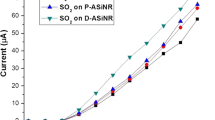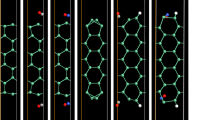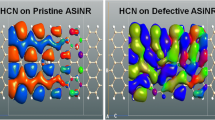Abstract
Using non-equilibrium Green’s function (NEGF) formalism combined with first-principle density functional theory (DFT), we explore the nature of adsorption of carbon-based gases and the resulting structural, electronic (band structure, density of states, Mulliken population, and electron density), and transport properties (current-voltage characteristics and transmission eigenstates) on pure and defected armchair silicene nanoribbons (ASiNRs) for sensing applications. It is observed that CH4 and CO2 are weakly adsorbed on pristine (P-ASiNR) as well as defective (D-ASiNR) nanoribbons owing to their low adsorption energy and charge transfer, thereby exhibiting low sensitivity and high recoverability. On the other hand, CO is chemisorbed on both nanoribbons exhibiting greater adsorption energy and current, thereby having more sensitivity and more recovery time. Mulliken population analysis reports that a significant amount of charge transfer prevails between ASiNR and gas molecules, validating our results for adsorption energies of the systems. CO2 and CO donates charge to the ASiNR, showcasing their electron-donating nature; contrariwise, CH4 behaves as electron-withdrawing gas by accepting electronic charge from ASiNRs. Our calculations reveal that introduction of vacancy defect increases the sensitivity significantly which is promising for future gas-sensing applications as well.







Similar content being viewed by others
References
Watson J, Ihokura K (1999) Gas-sensing materials. MRS Bull 24:14
Collins PG, Bradley K, Ishigami M, Zettl A (2000) Extreme oxygen sensitivity of electronic properties of carbon nanotubes. Science 287:1801
Kong J, Franklin NR, Zhou C, Chapline MG, Peng S, Cho K, Dai H (2000) Nanotube molecular wires as chemical sensors. Science 287:622
Li J, Lu Y, Ye Q, Cinke M, Han J, Meyyappan M (2003) Carbon nanotube sensors for gas and organic vapor detection. Nano Lett 3:929
Novak JP, Snow ES, Houser EJ, Park D, Stepnowski JL, McGill RA (2003) Nerve agent detection using networks of single-walled carbon nanotubes. Appl Phys Lett 83:4026
Qi P, Vermesh O, Grecu M, Javey A, Wang Q, Dai H (2003) Toward large arrays of multiplex functionalized carbon nanotube sensors for highly sensitive and selective molecular detection. Nano Lett 3:347
Valentini L, Armentano I, Kenny JM, Cantalini C, Lozzi L, Santuccia S (2003) Sensors for sub-ppm NO2 gas detection based on carbon nanotube thin films. Appl Phys Lett 82:961
Zhang D, Liu Z, Li C, Tang T, Liu X, Han S, Lei B, Zhou C (2004) Detection of NO2 down to ppb levels using individual and multiple In2O3 nanowire devices. Nano Lett 4:1919
Chopra S, McGuire K, Gothard N, Rao AM (2003) Selective gas detection using a carbon nanotube sensor. Appl Phys Lett 83:2280
Novoselov KS, Geim AK, Morozov SV, Jiang D, Zhang Y, Dubonos SV, Grigorieva IV, Firsov AA (2004) Electric field effect in atomically thin carbon films. Science 306:666
Berger C, Song Z, Li X, Wu X, Brown N, Naud C, Mayou D, Ji T, Hass J, Marchenkov AN, Conrad EH, First PN, de Heer WA (2006) Electronic confinement and coherence in patterned epitaxial graphene. Science 312:1191
Geim AK, Novoselov KS (2007) The rise of graphene. Nat Mater 6:183
Schedin F, Geim AK, Morozov SV, Hill EH, Blake P, Katsnelson MI, Novoselov KS (2007) Detection of individual gas molecules adsorbed on graphene. Nat Mater 8:652–655
He Q, Zeng Z, Yin Z, Li H, Wu S, Huang X, Zhang H (2012) Fabrication of flexible MoS2 thin-film transistor arrays for practical gas-sensing applications. Small 8:2994–2999
Late DJ, Huang Y-K, Liu B, Acharya J, Shirodkar SN, Luo J, Yan A, Charles D, Waghmare UV, Dravid VP (2013) Sensing behavior of atomically thin-layered MoS2 transistors. ACS Nano 7:4879
Huo N, Yang S, Wei Z, Li S-S, Xia J-B, Li J (2014) Photoresponsive and gas sensing field-effect transistors based on multilayer WS2 nanoflakes. Sci Rep 4:5209
O’Brien M, Lee K, Morrish R, Berner NC, McEvoy N, Wolden CA, Duesberg GS (2014) Plasma assisted synthesis of WS2 for gas sensing applications. Chem Phys Lett 615:6
Kou L, Frauenheim T, Chen C (2014) Phosphorene as a superior gas sensor: selective adsorption and distinct I–V response. J Phys Chem Lett 5:2675
Abbas AN, Liu B, Chen L, Ma Y, Cong S, Aroonyadet N, Köpf M, Nilges T, Zhou C (2015) Black phosphorus gas sensors. ACS Nano 9:5618
Peyghan AA, Noei M, Yourdkhani S (2013) Al-doped graphene-like BN nanosheet as a sensor for para-nitrophenol: DFT study. Superlattice Microst 59:115
Behmagham F, Vessally E, Massoumi B, Hosseinian A, Edjlali L (2016) A computational study on the SO2 adsorption by the pristine, Al, and Si doped BN nanosheets. Superlattice Microst 100:350
Chandiramouli R, Srivastava A, Nagarajan V (2015) NO adsorption studies on silicene nanosheet: DFT investigation. Appl Surf Sci 351:662–672
Aghaei SM, Monshi MM, Calizo I (2016) A theoretical study of gas adsorption on silicene nanoribbons and its application in a highly sensitive molecule sensor. RSC Adv 6:94417–94428
Walia GK, Randhawa DKK (2018) Electronic and transport properties of silicene based ammonia nanosensors: an ab initio study. Struct Chem 29:257. https://doi.org/10.1007/s11224-017-1025-9
Walia GK, Randhawa DKK (2018) First-principles investigation on defect-induced silicene nanoribbons - a superior media for sensing NH3, NO2 and NO gas molecules. Surf Sci 670:33. https://doi.org/10.1016/j.susc.2017.12.013
Walia GK, Randhawa DKK (2018) Adsorption and dissociation of sulphur based toxic gas molecules on silicene nanoribbons: a quest for high-performance gas sensors and catalysts. J Mol Model 24:94. https://doi.org/10.1007/s00894-018-3631-x
Nagarajan V, Chandiramouli R (2017) NO2 adsorption behaviour on germanene nanosheet - a first-principles investigation. Superlattice Microst 101:160
Ding Y, Nia J (2009) Electronic structures of silicon nanoribbons. Appl Phys Lett 95:083115
Drummond ND, Zolyomi V, Fal’ko VI (2012) Electrically tunable band gap in silicene. Phys Rev B Condens Matter 85:075423
Kara A, Enriquez H, Seitsonen AP, Voon LC, Vizzini S, Aufray B, Oughaddou H (2012) A review on silicene-new candidate for electronics. Sci Rep 67:1
Vogt P, De Padova DP, Quaresima C, Avila J, Frantzeskakis E, Asensio MC, Resta A, Ealet B, Lay GL (2012) Silicene: compelling experimental evidence for graphene like two-dimensional silicon. Phys Rev Lett 108:155501
Amorim RG, Scheicher RH (2015) Silicene as a new potential DNA sequencing device. Nanotechnol 26:154002
Zhao J, Liu H, Yu Z, Quhe R, Zhou S, Wang Y, Liu CC, Zhong H, Han N, Lu J, Yao Y, Wu K (2016) Rise of silicene: a competitive 2D material. Prog Mater Sci 83:24
Spencer MJS, Morishita T (2016) Silicene, vol 235. Springer Series in Materials Science, Switzerland
Ni Z, Liu Q, Tang K, Zheng J, Zhou J, Qin R, Gao Z, Yu D, Lu J (2012) Tunable bandgap in silicene and germanene. Nano Lett 12:113
Tsai WF, Huang C-Y, Chang T-R, Lin H, Jeng H-T, Bansil A (2013) Gated silicene as a tunable source of nearly 100% spin-polarized electrons. Nat Commun 4:1500
Sadeghi H, Bailey S, Lambert CJ (2014) Silicene-based DNA nucleobase sensing. Appl Phys Lett 104:103104
Tao L, Cinquanta E, Chiappe D, Grazianetti C, Fanciulli M, Dubey M, Molle A, Akinwande D (2015) Silicene field-effect transistors operating at room temperature. Nat Nanotechnol 10:227
Feng J-W, Liu Y-J, Wang H-X, Zhao J-X, Cai Q-H, Wang X-Z (2014) Gas adsorption on silicene: a theoretical study. Comput Mater Sci 87:218
Prasongkit J, Amorim RG, Chakraborty S, Ahuja R, Scheicher RH, Amornkitbamrung V (2015) Highly sensitive and selective gas detection based on silicene. J Phys Chem C 119:16934–16940
Hu W, Xia N, Wu X, Li Z, Yang J (2014) Silicene as a highly sensitive molecule sensor for NH3, NO and NO2. Phys Chem Chem Phys 16:6957–6962
Osborn TH, Farajian AA (2014) Silicene nanoribbons as carbon monoxide nanosensors with molecular resolution. Nano Res 7:945
Guzmán-Verri GG, Voon LLY (2007) Electronic structure of silicon-based nanostructures. Phys Rev B 76:075131
Cahangirov S, Topsakal M, Aktürk E, Şahin H, Ciraci S (2009) Two- and one-dimensional honeycomb structures of silicon and germanium. Phys Rev Lett 102:236804
Brandbyge M, Mozos J-L, Ordejón P, Taylor J, Stokbro K (2002) Density-functional method for nonequilibrium electron transport. Phys Rev B 65:165401
Zhao Q, Nardelli MB, Lu W, Bernholc J (2005) Carbon nanotube-metal cluster composites: a new road to chemical sensors? Nano Lett 5:847–851
Abadir GB, Walus K, Pulfrey DL (2009) Basis set choice for DFT/NEGF simulations of carbon nanotubes. J Comp Electron 8:1–9
Zhang Y-H, Chen Y-B, Zhou K-G, Liu C-H, Zeng J, Zhang H-L, Peng Y (2009) Improving gas sensing properties of graphene by introducing dopants and defects: a first-principles study. Nanotechnology 20:185504
Atomistix Toolkit version 2015.0. QuantumWise, Copenhagen. Available from: http://www.quantumwise.com
Li C, Yang S, Li SS, Xia JB, Li JB (2013) Au-decorated silicene: design of a high-activity catalyst toward CO oxidation. J Phys Chem C 117:483
Chen R, Franklin N, Kong J, Cao J, Tombler T, Zhang Y, Dai H (2001) Molecular photodesorption from single-walled carbon nanotubes. Appl Phys Lett 79:2258–2260
Hyman MP, Medlin JW (2005) Theoretical study of the adsorption and dissociation of oxygen on Pt(111) in the presence of homogeneous electric fields. J Phys Chem B 109:6304–6310
Poole CP Jr, Owens FJ (2003) Introduction to nanotechnology. John Wiley & Sons, Hoboken
Funding
We gratefully acknowledge funding support from Department of Science & Technology (DST) of India—Promotion of University Research and Scientific Excellence (PURSE) scheme. The authors would also like to thank Quantumwise for their valuable support. Walia GK wants to acknowledge University Grants Commission, New Delhi, India, for Senior Research Fellowship.
Author information
Authors and Affiliations
Corresponding author
Ethics declarations
Conflict of interest
The authors declare that they have no conflict of interest.
Rights and permissions
About this article
Cite this article
Walia, G.K., Randhawa, D.K.K. Gas-sensing properties of armchair silicene nanoribbons towards carbon-based gases with single-molecule resolution. Struct Chem 29, 1893–1902 (2018). https://doi.org/10.1007/s11224-018-1170-9
Received:
Accepted:
Published:
Issue Date:
DOI: https://doi.org/10.1007/s11224-018-1170-9




